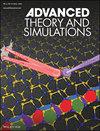Rational Design of TADF‐Based Organic Photoredox Catalysts: Insights from DFT‐Based Structure–Property Relationships
IF 2.9
4区 工程技术
Q1 MULTIDISCIPLINARY SCIENCES
引用次数: 0
Abstract
Organic photoredox catalysts (OPCs) are being developed as more sustainable options for use in visible‐light mediated transformations. In this study, using three donors (phenothiazine (PTZ), carbazole (CCz), and N‐substituted carbazole (NCz)), four diphenyl sulfone‐derived (DPS) acceptors, and two π‐bridges (phenyl (Ph) and pyrimidine (Pm)), 36 donor‐acceptor‐donor (D–A–D) structured OPCs are designed. Density functional theory (DFT) calculations are used to predict photophysical and redox properties, including highest occupied molecular orbital (HOMO)–lowest unoccupied molecular orbital (LUMO) gaps, ionization potential, electron affinity, absorption energies, and excited‐state redox potentials, of these OPCs. Molecules characterized by large singlet–triplet gaps (Δ基于TADF的有机光氧化还原催化剂的合理设计:基于DFT的结构-性能关系的见解
有机光氧化还原催化剂(OPCs)作为一种更可持续的选择正在被开发用于可见光介导的转化。在这项研究中,使用三个供体(吩噻嗪(PTZ),咔唑(CCz)和N -取代咔唑(NCz)),四个二苯基砜衍生物(DPS)受体和两个π桥(苯基(Ph)和嘧啶(Pm)),设计了36个供体-受体-供体(D-A-D)结构的OPCs。密度泛函理论(DFT)计算用于预测这些OPCs的光物理和氧化还原性质,包括最高已占据分子轨道(HOMO) -最低未占据分子轨道(LUMO)间隙、电离势、电子亲和、吸收能和激发态氧化还原电位。具有大单重态-三重态间隙的分子(ΔES1-Tn >;0.20 eV)是荧光OPCs,因此可以归类为适合单线态介导的电子转移。CCz_DPS和CCz_Ph_DPS是强效光还原剂(<;−1.70 V), CCz_Pm_DPmS和NCz_Pm_DPyS是良好的光氧化剂(>;+ 1.30 V)。相比之下,具有较小ΔES1-Tn (<;0.20 eV)分为系统间交叉优势(三重态介导)和反向系统间交叉优势(单线态介导)。PTZ_DPS被鉴定为强三重态光还原剂((T1) = - 1.73 V)。此外,将新设计的OPCs与已有的OPCs (4CzIPN和NCz - DPS)进行比较,发现前者具有更高的激发态氧化还原电位。总的来说,这些发现建立了基本的结构-性质相关性,并强调了具有可定制氧化还原活性的OPCs结构的设计原理,用于目标光催化功能。
本文章由计算机程序翻译,如有差异,请以英文原文为准。
求助全文
约1分钟内获得全文
求助全文
来源期刊

Advanced Theory and Simulations
Multidisciplinary-Multidisciplinary
CiteScore
5.50
自引率
3.00%
发文量
221
期刊介绍:
Advanced Theory and Simulations is an interdisciplinary, international, English-language journal that publishes high-quality scientific results focusing on the development and application of theoretical methods, modeling and simulation approaches in all natural science and medicine areas, including:
materials, chemistry, condensed matter physics
engineering, energy
life science, biology, medicine
atmospheric/environmental science, climate science
planetary science, astronomy, cosmology
method development, numerical methods, statistics
 求助内容:
求助内容: 应助结果提醒方式:
应助结果提醒方式:


